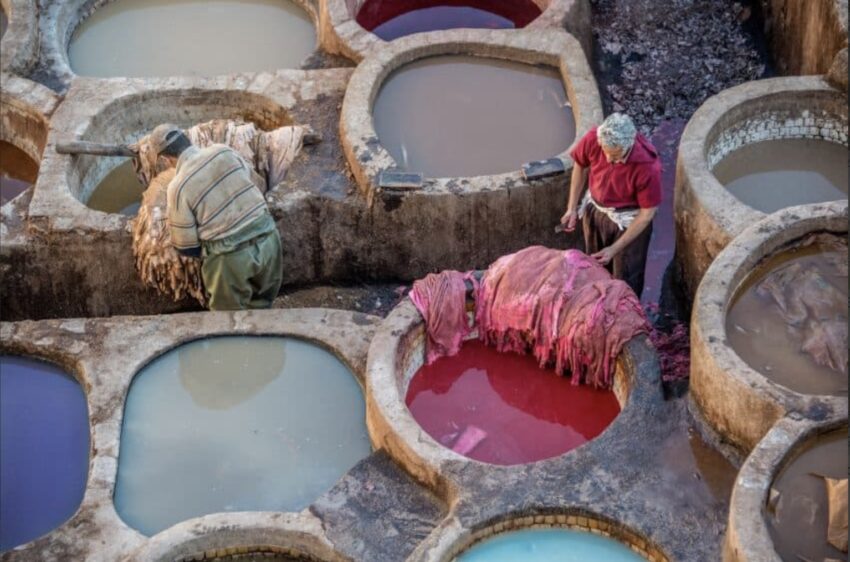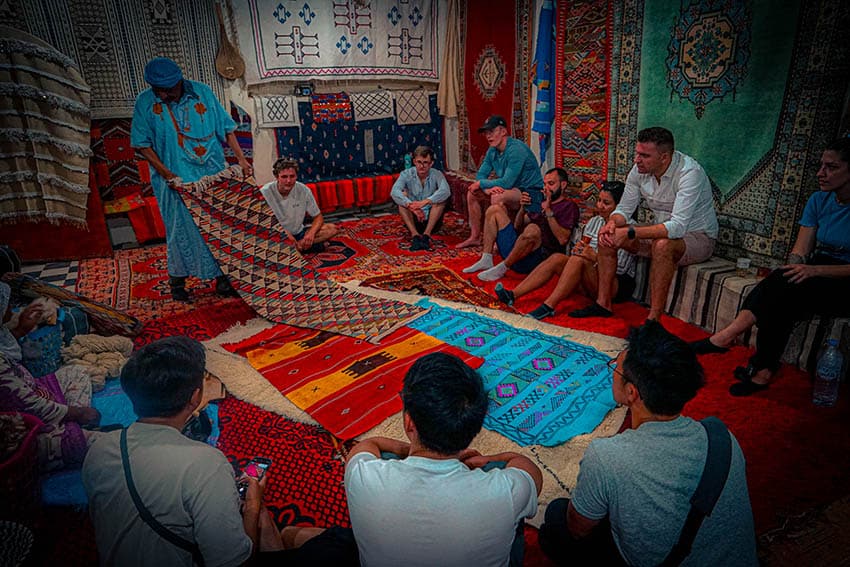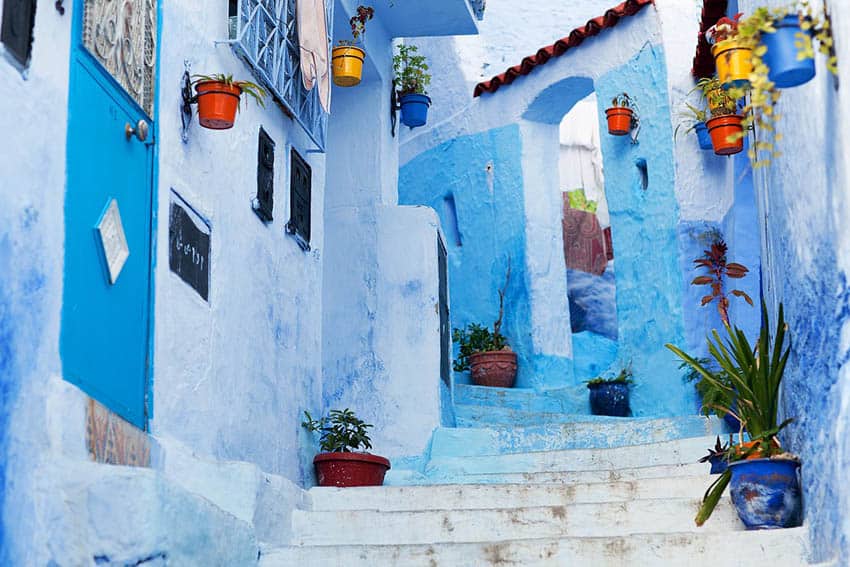
Fes is the King Among the Princes of Morocco
By Kalie Schumacher-Smith

The dictionary defines Morocco as a kingdom in northwest Africa. It couldn’t be more right.
Not only is Morocco a country, but also a kingdom. A kingdom of magnificence, uniqueness, and tradition. A kingdom that flaunts the pristine beauty of Casablanca, the industrialized capital Rabat, and the ancient charisma of Fes. Morocco, in its entirety, is truly a kingdom.
My photographer boyfriend, Sergio, and I decided to take a one-week tour to Morocco using the tour company Luxo Tours. The trip consisted of traveling, by bus, to 4 major cities in Morocco: Fes, Marrakech, Casablanca, and Rabat.
Fes at the Top of Her List
However, for me, no other city in Morocco can compare to Fes. There is an old Moroccan proverb that reads: Among walnuts only the empty one speaks. This proverb perfectly describes Fes, Morocco. Fes is the one corner of the world that preserves the “old city”, the empty walnut. It speaks of simpler times, a time that never changed for Fes.
Fes, the former capital of Morocco and the country’s third-largest city boasts its old-school charm. The city itself dates back to the year 789 and you can really grasp how ancient the city is by the old buildings and mannerisms of the city’s citizens.
Even though Fes is so old, it does have a “new city” that is modernized and has an effective commercial center. However, just a 10-minute walk and you are transformed into another world – the Medina of Fes.
The Oldest Part of Fes
The Medina or “old city” is the oldest part of Fes, dating back to the year 800. It is walled and designed as a labyrinth or maze which makes it almost impossible, if you are unfamiliar with it, to find your way out.
No cars are allowed within the Medina, however, bikes and donkeys crowd the narrow streets. The streets are filled, on a daily basis, with people going about their day, market stalls, animals, and endless different aromas and sounds. Street sellers rush up to tourists speaking a mixture of Spanish, English, and their native French and Arabic.
The best way to handle the street sellers, which can become very agitating after a while, is to either ignore them or say “la shokran” (‘no, thank you’ in Arabic) very firmly. Sometimes, however, ‘no’ doesn’t work as they will follow you until they realize you will not buy anything from them.
Very Poor Children Rob Tourists
Although they look cute and innocent, the children and their families are very poor. Tourists don’t expect the children to try and rob them which makes it easier for the children to silently pickpocket tourists. My boyfriend and I witnessed a young boy sticking his hand in the pocket of another person from our tour.
Once my boyfriend yelled “watch out!” the little boy ran off disappearing into the crowd of people. Our guide told us that it is very common for tourists to later check their pockets and find their wallets or money missing. The best thing to do is store everything in a book bag or fanny pack and keep them in front of you.
However, without the children, the Medina would not be the same. The children enjoy having their pictures taken and smiles light up their faces as you show them the photo. They laugh as you try to communicate with them in the little Arabic or French you know and will then, in turn, attempt to speak with you in your language. Young boys have the same responsibility as adult men and will be seen carrying loads of fruit and vegetables as they deliver the goods for their parents.
Children’s Laughter Creates the Medina
The children’s laughter, running, and shouting is what create the atmosphere of the Medina. The market stalls sell everything from colorful spices, Moroccan deserts, homemade goods, handmade crafts, live chickens, and fresh meat that is being sliced and cut right in front of you.
The sounds and aromas of the market stalls overwhelm you as you are drawn to the unique sight of people carving wood into beautiful figurines, women sculpting potted bowls from clay, old men creating intricate dresses on looms, and live chickens being carried through the streets, everyone knowing that those chickens will soon turn into lunch.
The markets are good places to purchase inexpensive hand-crafted items to take back as mementos. Bargaining is considered necessary and part of the culture. Most times, when asked the price of a good, the seller at the markets will say a price that is at least 30% higher than what the product is actually worth.
Therefore, bargaining and debating a price with the seller is important.
The Medina’s leather “factory” was one of the most perplexing sights of all. We observed the leather being made as we watched from the top of the leather store and had an aerial view of the process. When we first entered the building, the man standing in the doorway gave each of us mint leaves. We all wondered why we were given the mint but it didn’t take long to realize their purpose.

A Horrible Smell
The moment you step in, you are overcome with a smell so horrible that the mint leaves never depart your nostrils. The smell of a decaying body; an old rotten egg; fifteen wet dogs: all of these combined is the scent that overpowers you as you witness how leather is made in Fes.
Watching the view from on top of the building, you stare down and your eyes settle on a large square with at least a hundred giant clay circle “bathtubs” protruding from the ground. The clay “bathtubs” are filled with water, spices, tint, and animal excrement. Men, standing in the clay tubs, are covered up to their chest, in all these ingredients. The men dip freshly skinned cow hides into the mixture and then hang the hides to dry on a large clay wall.
Famous Tanneries in Fes
The special part about this process is that it is still hand-done, as it was hundreds of years ago. No assembly belts, no machines, and nothing to make the job easy. The men making the leather, which eventually turns into one-of-a-kind handbags and jackets, are working all day in the unbearable sun and stench. Watching the men do what they do day after day shows just how the old school work ethic of Medina will never die.
While walking the narrow stone streets of the Medina, our tour was fortunate enough to see a children’s school. However, what we saw cannot be described as a school but more as a “learning den”. The door to enter was about four feet tall and crouching was necessary to get inside. The inside walls and ceiling were made of stone. The width was about two person’s arm lengths and the ceiling was only about 6 feet tall.
A Cramped School Room in Fes
Inside this cramped room, seven small children, both boys, and girls, were seated at long wooden desks. The children had dirt on their faces and were wearing ragged clothing. They smiled shyly at us as we observed them learning. Three Moroccan women, all wearing Djellabas – the typical Moroccan robe –, were instructing the students in Arabic. On the back wall, hung a small chalkboard with writing on it in Arabic and French.
Although the school was menial, the children were intelligent. Not only do they learn and speak their own Arabic and French language, they also learn and speak English and Spanish. Learning more languages guarantees their survival and communication with foreigners. Witnessing the traditional school, it is evident how primeval the culture and atmosphere of the Fes Medina really are.
Donkey’s braying, people begging, the zingy scent of spices, the taste of culture, the touch of the past; in the Medina of Fes, your senses become alert. Your entire being is taken back to a time before skyscrapers, factories billowing smoke, stoplights, and automobiles. The ancient culture that creates the atmosphere seeps loosely through your pores.
No matter how much modernization happens in Morocco, the Medina of Fes will always be the same. You, however, will feel as a child, one that can never look at the world the same again.
Kalie Schumacher-Smith is an American who is currently living in Madrid, Spain teaching English as a foreign language. She loves writing, traveling, and photography and is also an animal rights activist.
- These 9 U.S. National Parks Require Reservations in 2024 - April 17, 2024
- Take a Hike in Olympic National Park - April 17, 2024
- The Wild Mississippi: 2340 Miles Across Ten States - April 8, 2024



